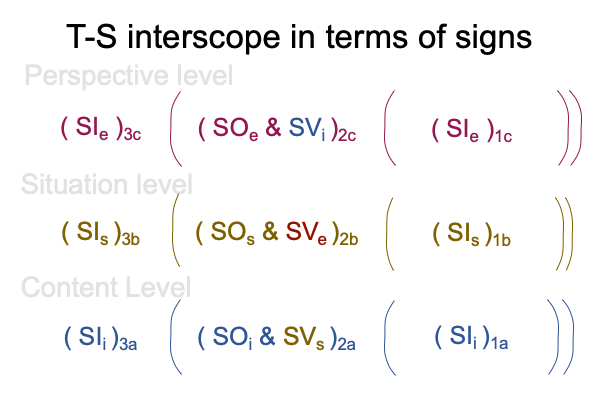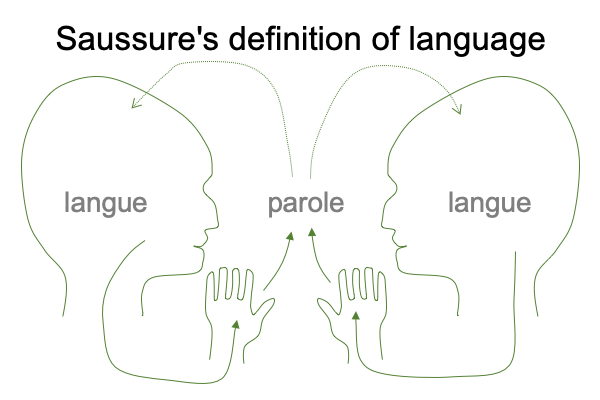0313 What about communication between teammates?
Obligate collaborative foraging involves teams. Yet, joint attention2a (in Tomasello’s vision) adapts to the sociogenesis of teams1a, not by organizing them1a, but by embodying them1a.
But, if teams1a are embodied by joint attention2a as an adaptation, then the inquirer gets drawn into a tautology. Joint attention2a adapts to the teams that sociogenesis1a creates. But, sociogenesis1a would not offer the team1a as a possibility, unless joint attention2a exists.
0314 How to get around this tautology?
In the Tomasello-Mah synthesis, joint attention2b virtually situates an actuality independent of the adapting species2a, which turns out to be triadic relations.

0315 The sociogenesis of teams1b manifests the potential of triadic relations2a. Not only is the team1b itself a purely relational structure consisting of a social circle with around 15 members, the team is the site for the embodiment of pairs of me-you relations, over 100 of them (for a team of 15). Not only is the social circle of the team the site for the embodiment of pairs of me-you relations, the team itself embodies the relational structure of icons and indexes characteristic of the specifying sign.
The LCA understands pantomime and pointing, even though the most theatrical specifying signs come in the style of emotion-laden situation-revealing gestures and vocalizations that are not under voluntary control. Pantomime and pointing are voluntary gestures requesting, informing and sharing, not information, but desires. Pantomime and pointing is typical for family (5) and friends (5).
The great apes (and the LCA) are not much interested in teamwork or joint attention.
The bipedal southern apes are.
The australopithecines start to generate intentional interventional signs in the course of team efforts.
In the process, the Tomasello-Scholastic interscope comes into play. In this three-level interscope, Tomasello’s insights of a common conceptual ground3c and the potential of mutual expectations1c take the place of the scholastic perspective-level normal context3c and potential1c.

0316 Here, semiotics proves valuable, as an alternate way of portraying the dynamics of the above interscope.
Manual-brachial gestures may be used to pantomime and to point. Pantomime goes with iconic natural signs, where the sign-object is rooted in the principle of similarity. Pointing goes with indexal natural signs, where the sign-object is rooted in the principle of contiguity.
0317 This explains the medium for talking for early hominins.
The arm and hand are under voluntary control. The voice is not. Voluntary control is necessary in order to intentionally generate an interventional sign-object2a (SOi) that is decoded into a specifying sign-vehicle2a (SVs).
The interventional sign-vehicle2c (SVi), in turn, is brought into being by an exemplar sign object2c (SOe).
Plus, the exemplar sign-vehicle2b (SVe) is contiguous with the specifying sign-object2b (SOs).
0318 Here is a picture of the Tomasello-scholastic interscope, framed in terms of the elements of specifying, exemplar and interventional sign-relations.

0319 How does this play out in the many me-you relations involved in each team?
Here is a diagram that appears in Looking at Michael Tomasello’s Book (2008) “The Origins of Social Communication”,located in Razie Mah’s blog for January 17-4, 2024.

0320 In hand talk among hominins engaged in joint attention, each individual, “me”, addresses another individual, “you”. The specifying sign-vehicle (SVs) or… is it?… the interventional sign-object (SOi) entangles “us”, as the “we” who belong to the normal context of what is happening3a operating on the potential of ‘something happening’1a (SIi).
0321 So, how is reference guaranteed?
Reference is guaranteed when the specifying sign-relation naturally perceives its sign-vehicle (SVs) as an icon and an index. The referent is outside of “us”. The referent appears to be a mind-independent being.
There are no word-games in early hominin hand-talk.
